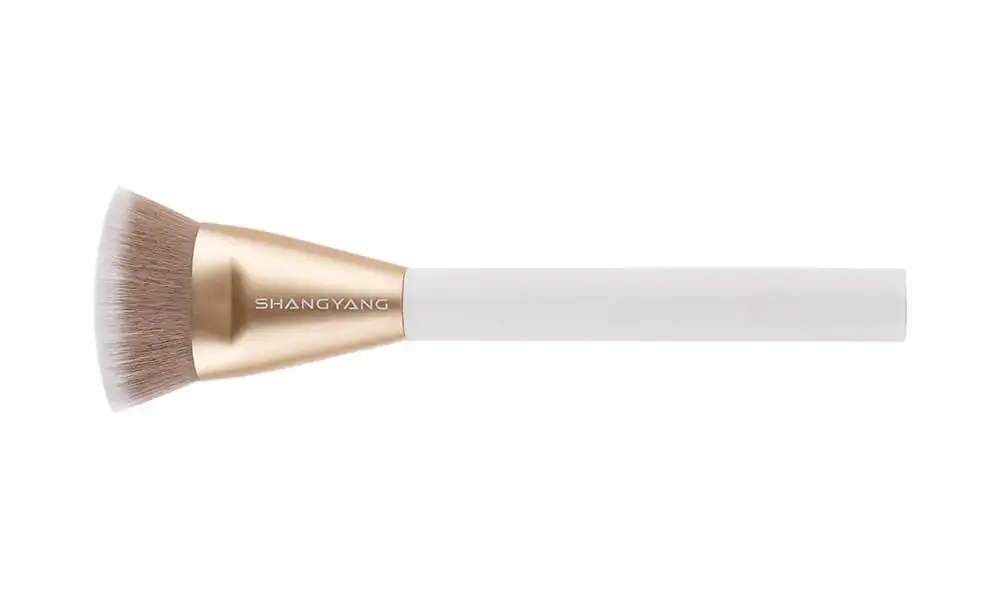In the world of makeup application,achieving a flawless,even base is key.But with so many brushes available,choosing the right tool for the job can be confusing.Enter the buffing brush,a hero product for creating a smooth,airbrushed finish.
What is a Buffing Brush?
A buffing brush is a makeup tool designed with densely packed bristles, typically arranged in a flat or slightly domed shape. This brush is primed for the seamless application and blending of powdered, liquid, or cream products onto the skin. Its purpose is to produce a smooth, high-definition finish by polishing makeup into the skin, thus diminishing visible lines and streaks.

The construction of a buffing brush may involve either natural or synthetic bristles, with synthetic options being more common due to their hypoallergenic qualities and suitability for cream-based products. An essential characteristic is the firm yet flexible bristle arrangement, which allows for controlled blending that enhances the makeup’s integration with the complexion.
Key Features:
- Bristle Density: Dense enough to blend products without absorbing them excessively.
- Bristle Shape: Often flat-topped or slightly rounded for optimal surface contact.
- Bristle Material: Commonly synthetic for versatility with various makeup textures.
Capable of multitasking, a buffing brush can be employed in a number of makeup techniques beyond mere foundation application. It is effective for softening harsh lines, ensuring that products like bronzer, blush, and contour seamlessly fuse with the base layer, a technique extolled by beauty aficionados and makeup artists alike.
Types of Buffing Brushes
Buffing brushes come in various shapes and sizes, each crafted to achieve different effects on the skin. They are primarily differentiated by their bristle type, density, and shape.
- Flat Top Buffing Brushes: These brushes have a flat top with densely packed bristles, making them ideal for a full-coverage finish. They are commonly used to apply and blend foundation for a smooth, high definition look.

- Angled Buffing Brushes: With slanted bristles, angled brushes are designed to fit the contours of the face, particularly useful for applying bronzer, blush, and contour products. Their angled shape helps in defining cheekbones and jawlines with precision.

- Dome-Shaped Buffing Brushes: These have a rounded top and are less dense than flat buffing brushes. They offer a softer application, which works well for products that require a lighter touch, such as mineral foundations or finishing powders.

- Triangle Buffing Brushes: The unique triangular design conforms to the curves of your face for seamless buffing of foundation, concealer, and cream products.
Here is a simple breakdown of the types of buffing brushes:
| Brush Type | Best For |
| Flat Top Buffing | Full-coverage foundation application |
| Angled Buffing | Contouring and defining |
| Dome-Shaped/ Triangle Buffing | Light application and mineral makeup |
Each type of brush serves a unique purpose in a makeup routine, and one may choose according to the desired finish and product consistency. For instance, stippling brushes with two sets of bristles are better for layers and achieving thin, streak-free coverage, while a traditional buffing brush is more suited for a polished, airbrushed effect.
Comparing Buffing Brushes to Other Brushes
Buffing brushes are distinguished by their dense bristles that allow for smooth, full-coverage application of makeup, particularly liquid foundation. Unlike stippling brushes that have two different sets of bristles, buffing brushes come with a single dense set, which is designed to blend makeup seamlessly into the skin for an airbrushed finish.
Stippling brushes, in contrast, generally possess a dual-fiber bristle design intended for lighter, buildable coverage. These brushes are particularly effective for achieving a streak-free finish and are better for thin, sheer application, as well as for covering blemishes and imperfections without looking heavy.

Another common type, flat foundation brushes, are typically used to paint on liquid or cream foundation but do not blend as thoroughly as buffing brushes. They might leave streaks if not blended properly, whereas a buffing brush would leave a more even and polished look.

When comparing buffing brushes to other makeup brushes, a vital aspect to consider is the final look one aims to achieve. Buffing brushes are excellent for a well-blended, full-coverage look, while other brushes offer varied finishes and coverage levels, from sheer to full.
| Brush Type | Bristle Type | Coverage | Best Use Case |
| Buffing Brush | Dense, Single-Set | Full | Blending for a polished finish |
| Stippling Brush | Dual-Fiber Set | Sheer to Medium | Light coverage, blemish-concealing |
| Flat Foundation Brush | Flat, Tapered | Varies | Initial application, not blending |
The buffing brush’s design lends itself to be a versatile tool in one’s makeup kit, accommodating those who prefer a more flawless and smooth complexion.
How to Use a Buffing Brush
- Swirl the brush in your chosen product (foundation, powder, etc.).
- Buff the product into the skin using circular motions. Focus on areas that tend to need more coverage.
- Use light pressure to avoid streaks or irritation.
- Clean your brush regularly with a gentle brush cleanser to prevent product buildup and bacteria growth.
Conclusion
A buffing brush is a valuable tool for any makeup lover who desires a flawless, airbrushed finish. With its versatility and ease of use, a buffing brush can help you achieve a variety of makeup looks, from sheer and natural to full coverage and dramatic.
More to read:






